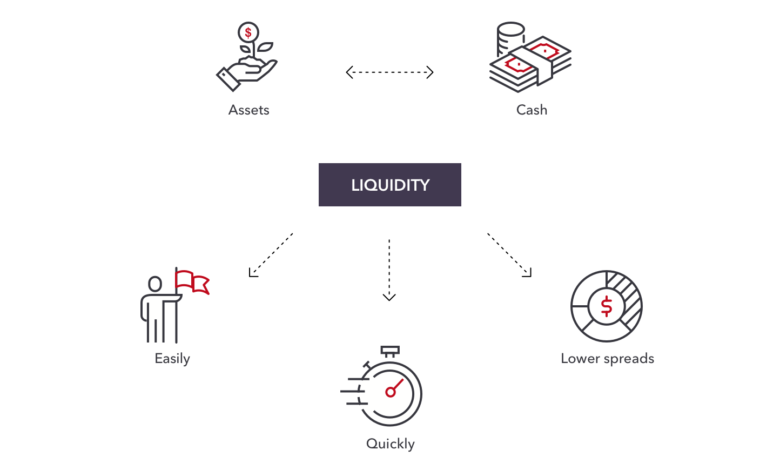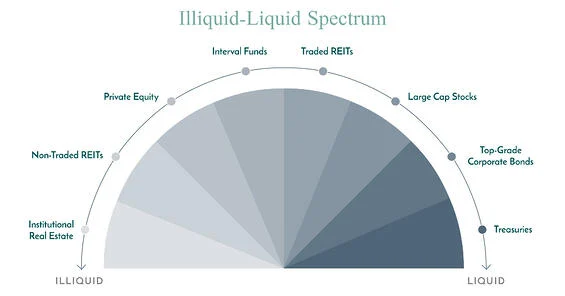Market Liquidity and its importance

Market Liquidity and its importance
Market liquidity explained
Liquidity refers to an asset’s ability to be bought and sold rapidly and at consistent prices. It measures the number of buyers and sellers present and the ease with which transactions may be completed. Liquidity is often calculated by taking the current volume of trades or the volume of pending trades on the market.
When there is a lot of trading and a lot of supply and demand for an item, it’s easier to locate a buyer or seller, which means there’s a lot of liquidity. It is an illiquid market or one with low liquidity if there are only a few market participants who trade infrequently.

Why is market liquidity so important?
Market liquidity is critical for many reasons, the most essential of which is that it affects how quickly you may initiate and close positions. Because someone is always prepared to take the other side of a particular position, a liquid market is generally associated with lower risk. This can draw in speculators and investors, further enhancing the market’s favourable conditions.
A seller can find a buyer in a liquid market without reducing the asset’s price to make it more enticing. A buyer, on the other hand, will not be required to pay a high price to obtain the asset they desire.
The liquidity of an asset influences the gap that a leveraged trading service, like IG, can offer. The term “high liquidity” refers to the underlying market’s large number of buy and sell orders. As a result, there is a greater chance that the highest price a buyer is ready to pay and the lowest price a seller is willing to accept may move closer together. To put it differently, the disparity between bid and offer will reduce.
Because we get our pricing from the underlying market, a lower bid-offer spread translates to lower platform spreads. If a market is illiquid, the spread may be significantly bigger.

How to use liquidity in trading?
Liquidity must be evaluated before every position is established or cancelled while trading financial markets. This is because a lack of liquidity is linked to greater risk.
It may be more challenging to terminate your position if the market is volatile, but there are fewer buyers than sellers. In this situation, you may find yourself in a losing position or have to visit many parties, each with a different fee, to fill your order.
Guaranteed stops, a type of stop-loss that ensures your trade is closed at the price level you specify, are one way to reduce liquidity risk. Guaranteed stops are immune to market fluctuations and can be a useful tool for navigating turbulent waters. You will incur a small fee if your assured stop is triggered.
The most important thing to remember is that market liquidity changes on a dynamic scale from high to low. Many factors influence the placement of a market on the spectrum, including the number of traders and the time of day.
You may find fewer market players and thus less liquidity if you trade an offshore market or a market not open to the public. There may be less liquidity on GBP forex pairings during Asian trading hours, for example.
What are the most liquid markets?
- Forex (major pairs)
- Large-cap stocks
- Commodities
Although these three financial markets are the most liquid, cash is the most liquid asset since it can be used to buy almost anything. As a result, most other assets’ liquidity is determined by how quickly and easily they may be changed into cash.

1. Forex and liquidity
Due to the large volume and regularity with which it is traded, forex is considered the most liquid market in the world.
Governments, huge banks, insurance companies, investment houses, dealers, and even vacationing persons all contribute to the massive volume of trades that occur on the forex market every day. Every day, more than $5 trillion is projected to be traded on the currency market.
Despite having a lot of liquidity, the FX market does not have consistent pricing. Due to the large number of people who trade important pairs, there are many different perspectives about what the price should be, resulting in daily price fluctuations. This is especially true while the market is digesting the news. Despite the high levels of volatility, prices are often kept within a range and traded in smaller amounts.
The big forex pairs — the most widely traded pairs – are widely thought to be the most liquid. This means that currency pairs like EUR/USD, GBP/USD, and USD/JPY have a lot of liquidity.
Liquidity is crucial in forex because it reduces the risk of slippage, allows for faster order execution, and allows for tighter bid-offer spreads.

2. Large-cap stocks and liquidity
To be considered liquid, a stock’s shares must be available to buy and sold quickly and with little impact on the stock’s price. A liquid stock is traded at least 100 times per day and has an average daily trading volume of at least $1 million, according to Canadian regulators.
The shares of companies listed on major stock exchanges are usually quite liquid. The term “large-cap” refers to stocks with a significant market capitalisation.
A corporation must have a market capitalisation of $10 billion or more to be considered a large-cap stock. They’re usually blue-chip stocks with a track record of earnings and revenue. According to conventional wisdom, companies with greater market capitalisations are more likely to have stable pricing and a higher number of traders, implying that shares may be changed to cash relatively fast.

3. Commodities
The liquidity of a market determines its accessibility. Commodity markets have traditionally been regarded as less liquid than other markets due to the actual delivery of assets, making them challenging to speculate on. Commodities are now easier to trade than ever before because of the advent of derivative instruments like CFDs, futures, ETFs, and ETNS.
Depending on the commodity you want to trade, there are different levels of liquidity. The most liquid commodities are those that are exchanged the most often, such as:
Crude oil. Crude oil is perhaps the most widely traded commodity on the planet, owing to its wide range of applications and trading options.
• Precious metals: Gold is the most liquid precious metal since it has the biggest trading volume and many items that may be utilised to trade the market.
• Sugar: Sugar has become one of the most commonly traded markets since it is the most common element in our diets. It was even dubbed “white gold” at one point.

What are the most illiquid markets?
1. Exotic forex pairs
2. Small-cap stocks
Exotic currency pairings and small-cap stocks are only two of the most illiquid financial markets, but there are plenty more. Real estate is the most illiquid investment market due to the length of time buying and selling a home.
- Exotic forex pairs and liquidity
Exotic currency pairs are a major pair and a developing or emerging market currency, like the Mexican peso, Hong Kong dollar, or Turkish Lira. Exotic pairings, by definition, are lightly traded, implying that they have less liquidity than major pairs.
This is due to the small number of market players who trade exotic pairs, which means there is little debate on the fair market price. When anything changes, there is usually a consensus of view, and the price adapts quickly, which can sometimes result in major price swings.
Because of the scarcity of liquidity, the bid-offer spread is typically much greater, and there is a lack of information on unusual pairs.
- Small-cap stocks and liquidity
Small-cap stocks have a market capitalisation of less than $2 billion and are traded on minor stock exchanges. They’re usually associated with a lack of liquidity and a higher level of risk.
Small-cap stocks aren’t traded as regularly as large-cap companies, so when there’s a demand for them, it may have a big impact on the market and cause a lot of volatility.
A lack of liquidity can result in unappealing prices at which to buy the stocks or difficulty selling stocks at a favourable price.

Measuring liquidity in Indian stock market: A dimensional perspective
Should Companies Always Have High Liquidity?
What Is High Liquidity?
The ability of a corporation to fulfil its debt obligations, or current liabilities, without having to obtain external money or take out loans is referred to as liquidity. High liquidity indicates that a corporation can quickly pay its short-term debts, whereas low liquidity indicates that a company is on the verge of bankruptcy.
KEY TAKEAWAYS INCLUDE:
Liquidity ratios are financial indicators used to assess a debtor’s capacity to repay current debt obligations without raising additional funds.
The quick, current, and days sales outstanding are examples of common liquidity ratios.
Liquidity ratios assess a company’s ability to cover short-term obligations and cash flows, whereas solvency ratios assess a company’s ability to pay down long-term debts.
Understanding High Liquidity
A company’s liquidity and financial health are indicated if it has a lot of cash or liquid assets on hand and can readily pay any debts in the near future. It could, but, be an indication that a corporation is not investing enough.
Current liabilities are compared to liquid assets to determine the coverage of short-term debts in the event of an emergency. The current ratio, quick ratio, and operating cash flow ratio are commonly used to assess liquidity. While a high liquidity value is beneficial in some situations, it is not always necessary for a corporation to maintain a high liquidity ratio. The liquidity ratio’s primary purpose is to assess a company’s ability to pay off all current debts with all current accessible assets. Analysts, creditors, and potential investors are all interested in a company’s stability and financial health, or lack thereof, and its efficiency in repaying debt.

Why Is a High Liquidity Ratio Not Essential?
The lower the liquidity ratio, the more likely the company will be in financial trouble shortly. Even said, a high liquidity rate isn’t always a desirable thing. A high liquidity ratio could show that the organisation is overly focused on liquidity, harming the efficient use of capital and business expansion. A company’s liquidity ratio may be remarkable.
Still, it may offer a negative picture to analysts and investors who will also analyse other measures of a company’s performance, like profitability ratios of the return on capital employed (ROCE) or return on equity. The return on capital employed measures a company’s efficiency in utilising available capital to maximise earnings. The capital used in relation to the net profit is calculated using a formula.
Liquid Funds: Basics, Things to consider and More
How Do Liquid Funds Work
The main goal of liquid funds is to provide investors with a high liquidity and capital security level. The fund manager invests in high-yield debt instruments with a 91-day maturity. The allocations are based on the investing goal of the fund. According to the fund manager, the portfolio’s average maturity will be three months. This makes liquid funds less vulnerable to interest rate swings by reducing the sensitivity of fund returns to interest rate movements.
The fund’s value does not fluctuate significantly. Furthermore, the underlying securities’ maturities are matched with the portfolio’s maturity. It aids in the production of higher profits. Liquid funds are a great place to put your spare cash. These are low-risk havens that pay out more than a traditional savings account. Liquid funds attempt to replicate the liquidity of a savings account. There is no lock-in period for these funds. You can generate larger returns using liquid funds like a normal savings account.
Types of Money Market Instruments
1. Certificate of Deposit (CD)
Term deposits are similar to fixed deposits in that they last for a set period of time. Scheduled commercial banks provide these services. The sole difference between FD and CD is that CDs cannot be withdrawn before the term’s end.
2. Commercial Paper (CP)
Companies and other financial institutions with a high credit rating issue commercial papers. Commercial papers, often known as promissory notes, are unsecured securities that are issued at a discount and redeemed at face value. The difference represents the investor’s profit.
3. Treasury Bills (T-bills)
The Indian government issues T-bills to raise funds for a period of up to 365 days. These are the safest instruments because the sovereign backs them. T-bills have a low rate of return, also known as the risk-free rate when compared to other securities.
Who Should Invest in Liquid Funds
Liquid funds are designed for people who have a lot of spare cash and seek safe havens to invest in for a short period. Rather than putting your extra cash in a savings account, you can put it in a liquid fund and earn significantly better rates. Surplus money can come from various sources, including performance-based incentives, bonuses, and other related gains from the sale of capital assets. Liquid funds can be utilised to invest in equities mutual funds. You could put the money in a liquid fund first, then move it to an equity fund of your choice over a set length of time.
Things to Consider as an Investor
1. Risk
The risk associated with mutual funds is the variation in net asset value (NAV). The NAV of liquid funds does not move very often since the underlying assets mature within 60 to 91 days, preventing the fund’s NAV from being greatly impacted by underlying asset price fluctuations. However, a sudden deterioration in the credit rating of the underlying asset could cause the fund’s value to plummet. To put it another way, liquid funds are not entirely risk-free.
2. Returns
Profits from liquid funds have historically ranged from 7% to 9%. It’s more than a savings bank account’s meagre 4% return. Liquid funds have historically generated positive returns upon redemption, despite their returns being not guaranteed.
3. Cost
Liquid funds charge a tiny fee to administer your investment, referred to as the expense ratio. The top limit of the expense ratio has been set at 1.05 per cent by SEBI. Liquid funds maintain a low expense ratio to deliver comparatively higher returns over the short term, owing to the fund manager’s hold till maturity approach.
4. Investment Horizon
Liquid funds are appropriate for investing excess capital for a limited time period, like three months. This short-term perspective assists you in realising the full potential of the underlying securities. If you have a longer investment horizon, say up to a year, you might want to explore investing in ultra-short-term funds to earn better returns.
5. Financial Goals
Liquid cash can be convenient when it comes to building an emergency reserve. These will help you earn larger returns, but they will also allow you to access your funds more rapidly in an emergency.
6. Tax on Gains
You make capital gains when you invest in debt funds, and these gains are taxable. The tax rate is determined by how long you invest in a debt fund. The holding period refers to the length of time you stay invested. Gains made in the first three years are known as short-term capital gains because liquid funds are a type of debt fund (STCG).
Long-term capital gains are defined as gains achieved after three years or more (LTCG). STCG from loan funds is added to your entire income and taxed according to your tax bracket. After indexation, LTCG from debt funds is taxed at a flat rate of 20%. Dividends offered by all mutual funds are added to your overall income and taxed at your income tax slab rate.
Top 5 Liquid Funds in India

1. Aditya Birla Sun Life Liquid Fund Growth
“Liquid funds invest in bonds with a three-month maturity.” They’re ideal for storing money set aside for an emergency or surplus money you won’t need for a few weeks to a year. You can expect higher returns than putting your money in a bank account.
These products are designed to outperform your bank account by a small margin. They provide consistent but low yields and are not ideal for long-term wealth accumulation.”
Taxability of earnings:
Capital gains:
• Gains on mutual fund units sold after three years from the investment date are taxed at a rate of 20% after inflation indexation is taken into account.
• If the mutual fund units are sold within three years of purchase, the whole gain is added to the investors’ income and taxed at the applicable slab rate; otherwise,
no tax is due as long as the units are held.
Dividends:
• Dividends are added to an investor’s income and taxed according to their tax brackets. In addition, if an investor’s dividend income exceeds Rs. 5,000 in a calendar year, the fund house deducts a 10% TDS before releasing the dividend.

2. Axis Liquid Fund Growth
Axis Liquid Direct Fund -Growth is an Axis Mutual Fund liquid mutual fund plan. This fund has been around for 9 years and 2 million dollars, starting on January 1, 2013. As of December 31, 2021, Axis Liquid Direct Fund -Growth had assets under management (AUM) of 28,047 crores, making it a medium-sized fund in its category.
• Axis Liquid Direct Fund has a one-year growth rate of 3.46 per cent. It has returned an average of 6.92 per cent per year since its inception.
• The ability of the Axis Liquid Direct Fund -Growth scheme to produce consistent returns is comparable to that of most funds in its category.
• The fund’s credit profile is moderate, indicating that it has lent to borrowers of good quality.
• Its ability to control losses in a dropping market is above average.
• The fund’s top holdings are Reserve Bank of India, Ultratech Cement Ltd., Tata Steel Ltd., Export-Import Bank Of India, and Reliance Retail Ventures Ltd. The fund’s top holdings are Reserve Bank of India, Ultratech Cement Ltd., Tata Steel Ltd., Export-Import Bank Of India, and Reliance Retail Ventures Ltd.

3. UTI Liquid Fund – Cash Plan-Growth
UTI Liquid Cash Direct-Growth is a UTI Mutual Fund Liquid mutual fund plan. This fund has been around for 9 years and 2 million dollars, starting on January 1, 2013. As of December 31, 2021, UTI Liquid Cash Direct-Growth had a total AUM of 27,815 crores, making it a medium-sized fund in its category. The fund’s expense ratio is 0.14 per cent.
• The 1-year returns on UTI Liquid Cash Direct-Growth are 3.47 per cent. It has returned an average of 6.89 per cent per year since its inception.
• The ability of the UTI Liquid Cash Direct-Growth scheme to produce consistent returns is comparable to that of most funds in its category. It has an above-average capacity to control losses in a sinking market.
• The Reserve Bank of India, Indian Oil Corpn. Ltd., Tata Steel Ltd., Reliance Retail Ventures Ltd., and Housing Development Finance Corpn. Ltd. are the fund’s top holdings.

4. ICICI Prudential Liquid Fund Growth
ICICI Prudential Liquid Fund Direct Plan-Growth is an Icici Prudential Mutual Fund liquid mutual fund strategy. This fund has been around for 9 years and 2 million dollars, starting on January 1, 2013. As of 31/12/2021, ICICI Prudential Liquid Fund Direct Plan-Growth has assets under management (AUM) of 42,892 crores, making it a medium-sized fund in its category.
• The ICICI Prudential Liquid Fund Direct Plan’s 1-year growth returns are 3.44 per cent. It has returned an average of 6.92 per cent per year since its inception.
• The ability of the ICICI Prudential Liquid Fund Direct Plan-Growth scheme to produce consistent returns is comparable to that of most funds in its category. It has an average capacity to control losses in a sinking market. The fund’s credit record is great, indicating that it has lent to high-quality customers. Because most funds in this category lend to stronger borrowers, the risk of default is higher in this fund than in others in the category.
• Reserve Bank of India, Bajaj Finance Ltd., Reliance Retail Ventures Ltd., Hindustan Petroleum Corpn. Ltd., and National Bank For Agriculture & Rural Development are the fund’s top holdings.

5. L&T Liquid Fund Growth
L&T Liquid Plan Direct-Growth is an L&T Mutual Fund Liquid mutual fund strategy. This fund has been around for 9 years and 2 million dollars, starting on January 1, 2013. L&T Liquid Plan Direct-Growth is a medium-sized fund with 4,143 crores in assets under management as of December 31, 2021. The fund’s expense ratio is 0.14 per cent.
• Last year’s L&T Liquid Plan Direct-Growth returns were 3.40 per cent. It has returned an average of 6.88 per cent per year since its inception.
• The ability of the L&T Liquid Plan Direct-Growth plan to provide consistent returns is comparable to that of most funds in its category. • The fund’s credit profile indicates that it has lent to borrowers of excellent quality.
• Its capacity to control losses in a dropping market is average. Because most funds in this category lend to similar borrowers, the risk of default is similar across the board.
• The Reserve Bank of India, Indian Oil Corpn. Ltd., Export-Import Bank Of India, Small Industries Devp. Bank of India Ltd. and Housing Development Finance Corpn. Ltd. are the fund’s top holdings.
edited and proofread by nikita sharma






